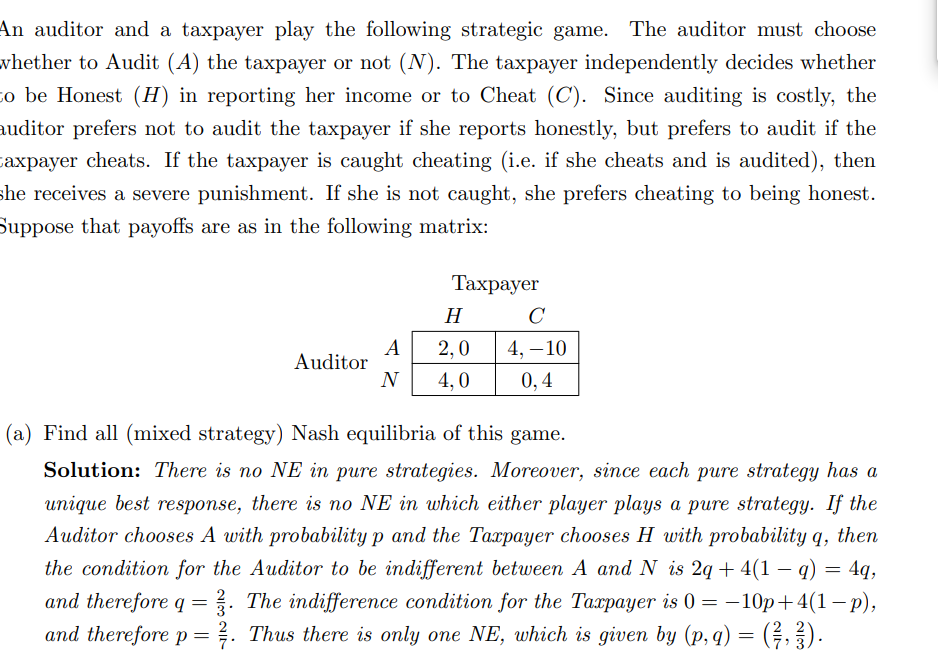an auditor and a taxpayer play the following strategic game. The auditor must choose hether to Audit (A) the taxpayer or not (N). The taxpayer independently decides whether o be Honest (H) in reporting her income or to Cheat (C). Since auditing is costly, the uditor prefers not to audit the taxpayer if she reports honestly, but prefers to audit if the axpayer cheats. If the taxpayer is caught cheating (i.e. if she cheats and is audited), then he receives a severe punishment. If she is not caught, she prefers cheating to being honest. uppose that payoffs are as in the following matrix: Auditor Taxpayer C H A 2,0 4,-10 N 4,0 0,4 (a) Find all (mixed strategy) Nash equilibria of this game.
an auditor and a taxpayer play the following strategic game. The auditor must choose hether to Audit (A) the taxpayer or not (N). The taxpayer independently decides whether o be Honest (H) in reporting her income or to Cheat (C). Since auditing is costly, the uditor prefers not to audit the taxpayer if she reports honestly, but prefers to audit if the axpayer cheats. If the taxpayer is caught cheating (i.e. if she cheats and is audited), then he receives a severe punishment. If she is not caught, she prefers cheating to being honest. uppose that payoffs are as in the following matrix: Auditor Taxpayer C H A 2,0 4,-10 N 4,0 0,4 (a) Find all (mixed strategy) Nash equilibria of this game.
Chapter8: Game Theory
Section: Chapter Questions
Problem 8.9P
Related questions
Question

Transcribed Image Text:An auditor and a taxpayer play the following strategic game. The auditor must choose
whether to Audit (A) the taxpayer or not (N). The taxpayer independently decides whether
to be Honest (H) in reporting her income or to Cheat (C). Since auditing is costly, the
auditor prefers not to audit the taxpayer if she reports honestly, but prefers to audit if the
axpayer cheats. If the taxpayer is caught cheating (i.e. if she cheats and is audited), then
she receives a severe punishment. If she is not caught, she prefers cheating to being honest.
Suppose that payoffs are as in the following matrix:
Auditor
Taxpayer
C
4, -10
0,4
H
A
2,0
N 4,0
(a) Find all (mixed strategy) Nash equilibria of this game.
Solution: There is no NE in pure strategies. Moreover, since each pure strategy has a
unique best response, there is no NE in which either player plays a pure strategy. If the
Auditor chooses A with probability p and the Taxpayer chooses H with probability q, then
the condition for the Auditor to be indifferent between A and N is 2q + 4(1 — q) = 4q,
and therefore q = 3. The indifference condition for the Taxpayer is 0= -10p+4(1-p),
and therefore p = . Thus there is only one NE, which is given by (p, q) = (1, 3).
-
Expert Solution
This question has been solved!
Explore an expertly crafted, step-by-step solution for a thorough understanding of key concepts.
This is a popular solution!
Trending now
This is a popular solution!
Step by step
Solved in 5 steps

Knowledge Booster
Learn more about
Need a deep-dive on the concept behind this application? Look no further. Learn more about this topic, economics and related others by exploring similar questions and additional content below.Recommended textbooks for you

